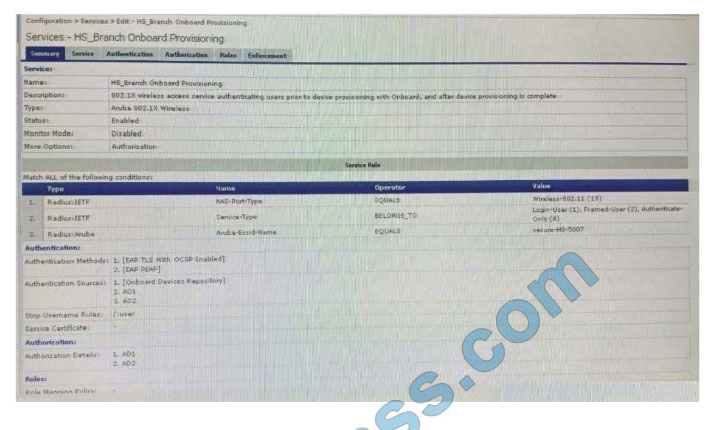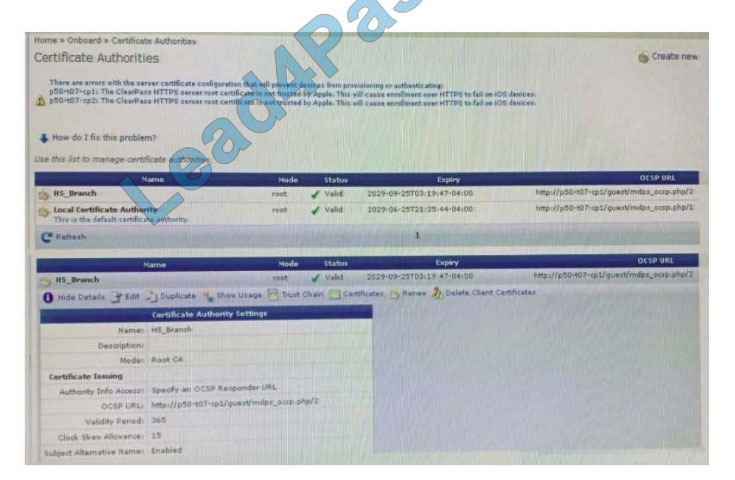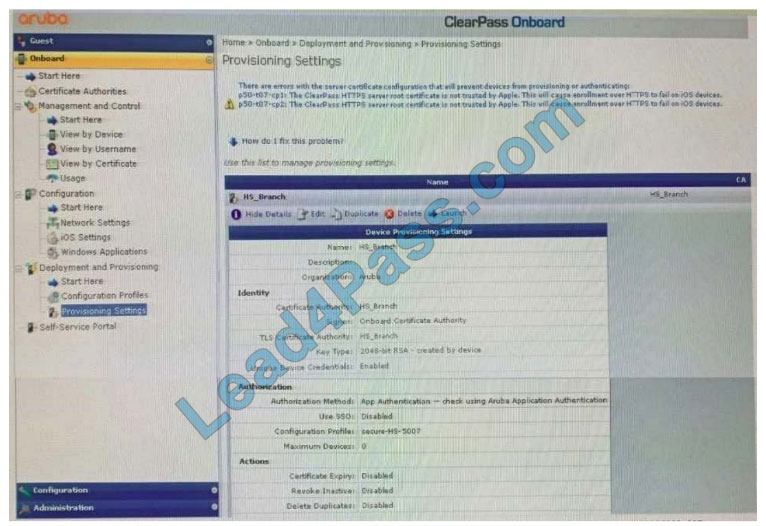The HPE6-A81 exam dumps maps to the Aruba Certified ClearPass Specialist written exam objectives:
Design, configure and troubleshoot various ClearPass products commonly used in large-scale customer deployments. This includes ClearPass Policy Manager, Guest, Analytics, Onboarding, Onguard, Status, Clustering, Redundancy, and External Server Integration.
Aruba Certified ClearPass Expert Written Exam, one of the top IT certifications in 2022. Using Lead4Pass HPE6-A81 Exam Dumps: https://www.leads4pass.com/hpe6-a81.html, the page contains
PDF and VCE’s most popular study tools to help you successfully pass the Aruba Certified ClearPass Expert Written Exam.
Aruba Certified ClearPass Expert Written Exam Materials have been verified by subject matter experts to be authentic and effective, and the HPE6-A81 Dumps exam questions meet the requirements of the real core exam questions and are passed the Aruba Certified ClearPass Expert Written Exam the best material.
Details of the HPE6-A81 exam you need to know:
Vendor: HP
Exam Code: HPE6-A81
Exam Name: Aruba Certified ClearPass Expert Written Exam
Certification: Aruba Certified ClearPass Professional (ACCP)
Number of questions: 60
Types of questions: multiple responses, single response
Exam duration: 2 hours
Passing score: 65%
Languages: English
Exam Type: Proctored
Next, get a portion of the hpe6-a81 exam dumps for free:
QUESTION 1:
Refer to the exhibit:





You have configured Onboard and cannot get it working The customer has sent you the above screenshots.
How would you resolve the issue?
A. Re-provision the client by running the QuickConnect application as Administrator
B. Install a public signed server authentication certificate on the ClearPass server for EAP
C. Reconnect the client and select the correct certificate when prompted
D. Copy the [EAP-TLS with OSCP Enabled] authentication method and set the correct OCSP URL
Correct Answer: A
QUESTION 2:
You are integrating a Postgres SQL server with the ClearPass Policy Manager.
What steps will you follow to complete the integration process? (Select three)
A. Click on the default filter name with pre-defined filter queries and check the box to enable as role.
B. Specify a new filter with filter queries to fetch authentication and authorization attributes.
C. Attribute Name under filter configuration must match one of the columns being requested from the database table.
D. Create a new Endpoint context server and add the SQL server IP, credentials, and database name.
E. Alias Name under filter configuration must match one of the columns being requested from the database table.
F. Create a new authentication source and add the SQL server IP, credentials, and database name.
Correct Answer: BDF
QUESTION 3:
A customer has completed all the required configurations in the Windows server in order for Active Directory Certificate Services (ADCS) to sign Onboard device TLS certificates.
The Onboard portal and the Onboard services are also configured.
Testing shows that the Client certificates ate still signed by the Onboard Certificate Authority and not ADCS.
How can you help the customer with the situation?
A. Educate the customer that, when integrating with Active Directory Certificate Services (ADCS) the Onboard CA will the same authority used for signing me final TLS certificate of the device.
B. Configure the identity certificate signer as Active Directory Certificate Services and enter the ADCS URL
http://ADCSVVeoEnrollmentServemostname/certsrv in the OnBoard Provisioning settings.
C. Enable access to EST servers from the Certificate Authority to make ClearPass Onboard to use of the Active Directory Certificate Services (ADCS) web enrollment to sign the device TLS certificates.
D. Enable access to SCEP servers from the Certificate Authority to make ClearPass Onboard to use of the Active Directory Certificate Services (ADCS) web enrollment to sign the device TLS certificates.
Correct Answer: C
QUESTION 4:
How does the RadSec improve the RADIUS message exchange? (Select two.)
A. It can be used on an unsecured network or the Internet.
B. It builds a TTLS tunnel between the NAD and ClearPass.
C. Only the NAD needs to trust the ClearPass Certificate.
D. It encrypts the entire RADIUS message.
E. It uses UDP to exchange the radius packets.
Correct Answer: DE
QUESTION 5:
A customer has deployed an OnGuard Solution to all the corporate devices using a group policy rule to push the OnGuard Agents.
The network administrator is complaining that some of the agents are communicating to the ClearPass server that is located in a DMZ, outside the firewall The network administrator wants all of the agents System Health Validation traffic to stay inside the Management subnets.
What can the ClearPass administrator do to move the traffic only to the ClearPass Management Ports?
A. Edit the agent.conf file being deployed to the clients to use the ClearPass Management Port for SHV updates.
B. Select the correct OnGuard Agent installer, and use the one configured for Management Port for the clients.
C. Configure a Policy Manager Zone mapping so the OnGuard agent will use the Management Port IP.
D. Filter TCP port 6658 on the firewall, forcing the OnGuard agent to use the ClearPass Management port.
Correct Answer: C
QUESTION 6:
A customer is complaining that some of the devices, in their manufacturing network, are not getting profiled while other loT devices from the same subnet have been correctly profiled.
The network switches have been configured for DHCP IP helpers and IF-MAP has been configured on the Aruba Controllers.
What can the customer do to discover those devices as well? (Select two.)
A. Update the Fingerprints Dictionary to the latest in case new devices have been added.
B. Open a TAC case to help you troubleshoot the DHCP device profile functionality.
C. Add the ClearPass Server IP as an IP helper-address on the default gateway as well.
D. Allow time for IF-MAP service on the controller to discover the new devices as well.
E. Manually create a new device fingerprint for the devices that are not being profiled.
Correct Answer: DE
QUESTION 7:
You have recently implemented a serf-registration portal in ClearPass Guest to be used on a Guest SSID broadcast from an Aruba controller. Your customer has started complaining that the users are not able to reliably access the internet after clicking the login button on the receipt page.
They tell you that the users will click the login button multiple times and alter about a minute they gain access.
What could be causing this issue?
A. The self-registration page is configured with a 1-minute login delay.
B. The guest client is delayed getting an IP address from the DHCP server.
C. The guest users are assigned a firewall user role that has a rate limit.
D. The enforcement profile on ClearPass is set up with an lETF:session delay.
Correct Answer: A
QUESTION 8:
You have configured a Guest SSID with Captive-portal Web Authentication and MAC authentication The MAC caching expiry time set to 12 hours and the Guest Account expiration time is set to 8 hours.
What will happen if the guest were to disconnect from the SSID and re-connect 9 hours later?
A. The client will tail the MAC authentication and be denied access to the Guest SSID.
B. The client will successfully pass the mac authentication until the mac caching time expires.
C. The client will successfully pass the MAC authentication but still be redirected to captive portal page.
D. The client will fail the MAC authentication and will be redirected to the Captive-portal login page.
Correct Answer: C
QUESTION 9:
Refer to the exhibit:

When creating a new report, there is an option to send report Notifications by Email.
Where is the email server configured?
A. In the ClearPass Policy Manager Endpoint Context servers under Administration.
B. In the Insight Reports Interface under Administration on the sidebar menu.
C. In the insight report on the next screen of the report definition.
D. In the ClearPass Policy Manager Messaging setup under Administration.
Correct Answer: B
QUESTION 10:
Refer to the exhibit:

A customer has configured onboard in a cluster with two nodes All devices were onboarded in the network through node1 but those clients tail to authenticate through node2 with the error shown.
What steps would you suggest to make provisioning and authentication work across the entire cluster? (Select three.)
A. Have all of the BYOD clients re-run the Onboard process
B. Configure the Onboard Root CA to trust the Policy Manager EAP certificate root.
C. Have all of the BYOD clients disconnect and reconnect to me network
D. Make sure that the EAP certificates on both nodes are issued by one common root Certificate Authority (CA).
E. Make sure that the HTTPS certificate on both nodes is issued as a Code Signing certificate
F. Configure the Network Settings in Onboard to trust the Policy Manager EAP certificate
Correct Answer: BDF
QUESTION 11:
A Customer has these requirements:
*
2.000 loT endpoints that use MAC authentication
*
6,000 endpoints using a mix of username/password and certificate (Corporate/BYOD) based authentication
*
1,000 guest endpoints at peak usage that use guest self-registration
*
1500 BYOD devices estimated as 3 devices per User (500 users)
*
2,500 endpoints that have OnGuard installed and connect on a daily basis
What licenses should be installed to meet customer requirements?
A. 11,500 Access, 500 Onboard, 2,500 Onguard
B. 13.000 Access, 1.500 Onboard, 2,500 Onguard
C. 11,500 Access, 1,500 Onboard, 2.500 Onguard
D. 9,000 Access, 500 Onboard. 2.500 Onguard
Correct Answer: C
QUESTION 12:
What type of EAP certificate are you able to use on ClearPass? (Select two.)
A. Self signed, when all the clients are Onboarded with the same Root CA as the Self signed certificate.
B. Private signed, when the clients are onboarded or are part of the organization domain.
C. Private signed, when some clients are onboarded and some are not part of the organization.
D. Public signed, when not all of the clients are part of the organization domain.
E. Self signed, when all the clients are part of the organization domain.
Correct Answer: CD
QUESTION 13:
A customer is looking to implement a Web-Based Health Check solution with the following requirements:
for the HR user\’s client devices, check if a USB stick is mounted.
for the RandD user\’s client devices, check if the hard disk is fully encrypted.
The Web-Based Health Check service has been configured but the customer it is not sure how to design
the Profile Policy.
How can be accomplished this customer request?
A. create two Posture Policies and customize the OnGuard Agent (Persistent or Dissolvable) to select the correct SHV checks
B. create one Posture Policy and define Rules Conditions that will apply different Tokens for each SHV check condition
C. create two Posture Policies and use the Restrict by Roles option to filter for HR and RandD user roles and apply the correct SHV checks
D. create one Posture Policy to check the HR users client devices and use the NAP Agent to check RandD users client devices
Correct Answer: A
……
[Online Download]HPE6-A81 exam dumps Materials:https://drive.google.com/file/d/1OUftMubHUZB7tCdHXOVwFJMNWUhIoxJo/
Get the full Aruba Certified ClearPass Expert Written Exam Materials: Click Here